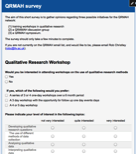Alarcon, P., Wieland, B., Mateus, A. L. P., & Dewberry, C. (2013). Pig farmers’ perceptions, attitudes, influences and management of information in the decision-making process for disease control. Preventive Veterinary Medicine. doi:10.1016/j.prevetmed.2013.08.004
Anneberg, I., Vaarst, M., & Sørensen, J. T. (2012). The experience of animal welfare inspections as perceived by Danish livestock farmers: A qualitative research approach. Livestock Science, 147(1-3), 49–58. doi:10.1016/j.livsci.2012.03.018
Bagnol, B. (2001). The Social Impact of Newcastle Disease Control. In R. G. Alders & P. Spradbrow (Eds.), Planning Workshop on Newcastle Disease Control. Proceedings of an International Workshop (pp. 69–75). Maputo, Mozambique, 6-9 March 2000. ACIAR PRoceedings No. 103. Retrieved from http://aciar.gov.au/files/node/2131/pr103chapter16.pdf
Burke, J., & Roderick, S. (2006). Examination of the impact and effectiveness of herd health and welfare assessment in improving animal welfare on organic dairy farms , using qualitative interviews . In Joint Organic Conference. Odense, Denmark. Retrieved from http://orgprints.org/7559/
Burton, R. J. F., Peoples, S., & Cooper, M. H. (2012). Building “cowshed cultures”: A cultural perspective on the promotion of stockmanship and animal welfare on dairy farms. Journal of Rural Studies, 28(2), 174–187. doi:10.1016/j.jrurstud.2011.12.003
Convery, I., Bailey, C., Mort, M., & Baxter, J. (2005). Death in the wrong place? Emotional geographies of the UK 2001 foot and mouth disease epidemic. Journal of Rural Studies, 21(1), 99–109. doi:10.1016/j.jrurstud.2004.10.003
Delgado, A. H., Norby, B., Dean, W. R., McIntosh, W. A., & Scott, H. M. (2012). Utilizing qualitative methods in survey design: examining Texas cattle producers’ intent to participate in foot-and-mouth disease detection and control. Preventive Veterinary Medicine, 103(2-3), 120–35. doi:10.1016/j.prevetmed.2011.09.012
Derks, M., van Woudenbergh, B., Boender, M., Kremer, W., van Werven, T., & Hogeveen, H. (2013). Veterinarian awareness of farmer goals and attitudes to herd health management in The Netherlands. Veterinary Journal (London, England : 1997), 198(1), 224–8. doi:10.1016/j.tvjl.2013.07.018
Enticott, G. (2012). The local universality of veterinary expertise and the geography of animal disease. Transactions of the Institute of British Geographers, 37(1), 75–88. doi:10.1111/j.1475-5661.2011.00452.x
Harper, G. C., & Makatouni, A. (2002). Consumer perception of organic food production and farm animal welfare. British Food Journal, 104(3/4/5), 287–299. doi:10.1108/00070700210425723
Hektoen, L. (2004). Investigations of the motivation underlying Norwegian dairy farmers’ use of homoeopathy. Veterinary Record, 155, 701–707.
Hernández-Jover, M., Gilmour, J., Schembri, N., Sysak, T., Holyoake, P. K., Beilin, R., & Toribio, J. L. M. L. (2012). Use of stakeholder analysis to inform risk communication and extension strategies for improved biosecurity amongst small-scale pig producers. Preventive Veterinary Medicine, 104(3-4), 258–70. doi:10.1016/j.prevetmed.2011.12.006
Jansen, J., Steuten, C. D. M., Renes, R. J., Aarts, N., & Lam, T. J. G. M. (2010). Debunking the myth of the hard-to-reach farmer: effective communication on udder health. Journal of Dairy Science, 93(3), 1296–306. doi:10.3168/jds.2009-2794
Kaler, J., & Green, L. E. (2013). Sheep farmer opinions on the current and future role of veterinarians in flock health management on sheep farms: a qualitative study. Preventive Veterinary Medicine, 112(3-4), 370–7. doi:10.1016/j.prevetmed.2013.09.009
Lastein, D. B., Vaarst, M., & Enevoldsen, C. (2009). Veterinary decision making in relation to metritis--a qualitative approach to understand the background for variation and bias in veterinary medical records. Acta Veterinaria Scandinavica, 51, 36. doi:10.1186/1751-0147-51-36
Meek, A. H., Martin, S. W., Mcmillan, I., Blackburn, D. J., & Grieve, D. G. (1982). The influence of socio-psychological aspects of managers on disease occurence & productivity in dairy herds. In 3rd International Symposium on Veterinary Epidemiology and Economics (pp. 266–273).
Mort, M., Convery, I., Baxter, J., & Bailey, C. (2005). Psychosocial effects of the 2001 UK foot and mouth disease epidemic in a rural population: qualitative diary based study. BMJ (Clinical Research Ed.), 331(7527), 1234. doi:10.1136/bmj.38603.375856.68
Nahar, N., Uddin, M., Gurley, E. S., Khan, M. S. U., Hossain, M. J., Sultana, R., & Luby, S. P. (2012). Pig illnesses and epidemics: a qualitative study on perceptions and practices of pig raisers in Bangladesh. Veterinaria Italiana, 48(2), 157–65. Retrieved from http://www.ncbi.nlm.nih.gov/pubmed/22718332
Sawford, K., Vollman, A. R., & Stephen, C. (2013). A focused ethnographic study of Alberta cattle veterinarians’ decision making about diagnostic laboratory submissions and perceptions of surveillance programs. PloS One, 8(5), e64811. doi:10.1371/journal.pone.0064811
Vaarst, M., Paarup-Laursen, B., Houe, H., Fossing, C., & Andersen, H. J. (2002). Farmers’ choice of medical treatment of mastitis in Danish dairy herds based on qualitative research interviews. Journal of Dairy Science, 85(4), 992–1001. doi:10.3168/jds.S0022-0302(02)74159-3
Birke, L., Hockenhull, J., & Creighton, E. (2010). The Horse’s Tale: Narratives of Caring for/about Horses. Society & Animals, 18(4), 331–347. doi:10.1163/156853010X524307
Buckley, P., Dunn, T., & More, S. J. (2004). Owners’ perceptions of the health and performance of Pony Club horses in Australia. Preventive Veterinary Medicine, 63(1-2), 121–33. doi:10.1016/j.prevetmed.2004.01.013
Cassidy, R. (2002). The Sport of Kings: Kinship, Class and Thoroughbred Breeding in Newmarket. New York: Cambridge University Press.
Christley, R. M., & Perkins, E. (2010). Researching hard to reach areas of knowledge: qualitative research in veterinary science. Equine Veterinary Journal, 42(4), 285–6. doi:10.1111/j.2042-3306.2010.00074.x
Helgadóttir, G., & Sigurðardóttir, I. (2008). Horse‐based Tourism: Community, Quality and Disinterest in Economic Value. Scandinavian Journal of Hospitality and Tourism, 8(2), 105–121. doi:10.1080/15022250802088149
Litva, A., Robinson, C. S., & Archer, D. C. (2010). General Articles Exploring lay perceptions of the causes of crib-biting / windsucking behaviour in horses, 42, 288–293. doi:10.1111/j.0425-1640.2009.00025.x





